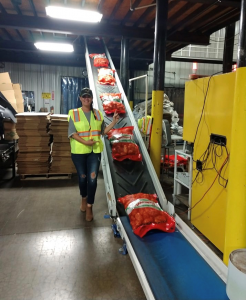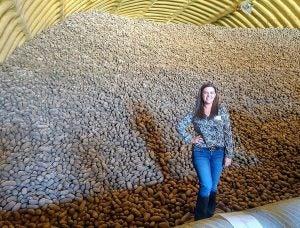When you think of potatoes, what’s the first U.S. state that comes to mind? Chances are, it’s Idaho!
I was super grateful to the Idaho Potato Commission for having me out for tours during harvest this fall. Potatoes are harvested now, and they’re usually finished by mid-October, before the heavy frost starts rolling in. (They’re planted in April or May.) Fun fact: The kids in the area get off of school for two weeks to help during harvest! It’s all-hands-on deck, a strong community effort, and a huge part of the Idaho economy and culture. Students may sometimes earn around $800 or $900 in six days of helping!
So what do they do? This little video explains:
After potatoes are harvested, they’re unloaded from these trucks, where students and other employees pick out rocks, branches, and other debris before the crop is loaded up again and sent off for processing.
But let’s take a step back. What does harvest actually look like? Here’s a quick glimpse:
Idaho is known for their potatoes thanks to warm days, cool nights, mountain-fed irrigation, and rich volcanic soil, among other things. Potatoes are rotated with other grain crops, meaning they might grow in the field this year, but next year it could be something else — which helps to interrupt pest pressure and puts different nutrients back in the soil.
What kind of pest pressure? The potato crop is susceptible to nematodes and beetles in this area, especially, so typically one application of insecticide is needed toward the beginning of the growing season. They’re also susceptible to white mold, so typically three applications of fungicide are needed to control that as well. Lastly, one application of herbicide to kill weeds is used at planting, and one application is used three weeks prior to harvest.
I found this interesting. If you’ve ever grown potatoes in your garden, you know that potatoes (called “tubers”) grow underground but their stems and leaves grow above ground. Those leaves must be sprayed and/or chopped off so the underground potato skin “firms up” in time for harvest and the nutrients are balanced for the crop. Failure to do this may result in soft skinned potatoes, which can become damaged or have a shorter shelf life. Yields are important; so is mitigating food waste and our carbon footprint. Resources to grow crops are precious, and it’s important to take care of them as best as we can!
I like to bring up this topic because there is a lot of misinformation out there with regards to chemical use, and I think transparency and understanding are a very important part of agricultural communication. Pesticides are used very minimally — usually at a rate of ounces per acre — by highly regulated and professionally licensed applicators. And potatoes are very thoroughly washed before they go to market.
Yep, that’s right! Washed, washed, and more washed (with recycled, clean water!). After potatoes are unloaded here, they go through a very extensive process of testing, grading, sizing, etc. Here’s what that looks like:
Next, they’re bagged here for the “fresh market” potatoes. They’ll either be ranked a #1, #2, or processed.
- #1 (about 70 percent of production) potatoes may go into nice restaurants … think your high end steakhouses.
- #2 (about 20 percent) may be sliced for French fries.
- Lastly, about 10 percent of potatoes harvested may be “ugly” so they’ll be turned into potato flakes. Blemished and defective potatoes scraps can also be fed to livestock!

The Idaho potato world is an impressive one. To think that as the No. 1 state of potato production in the country, they produce 13 billion pounds per year on over 310,000 acres. If you took the Idaho potato harvest and stacked them all up, the “potato mountain” would be over a MILE high and about the size of a football field!
Here I am in a storage cellar, 5 million pounds! The room is kept at 42 degrees Fahrenheit at the perfect moisture and humidity to keep them fresh. Fun fact: Potatoes can be stored here and stay good for nearly a year!

So there you have it, a look inside one of the most impressive potato harvests out there. After these processes take place, they’re weighed, packaged, labeled, bagged, and shipped all over the world! Mechanization is also an important part of this. Take a look at this video that’s moving 50-pound bags and multiple sacks of potatoes at once!
Think about all this hard work and impressive process the next time you buy potatoes and look for the Idaho seal.
Michelle Miller, the Farm Babe, is an Iowa-based farmer, public speaker, and writer, who lives and works with her boyfriend on their farm, which consists of row crops, beef cattle, and sheep. She believes education is key in bridging the gap between farmers and consumers.



